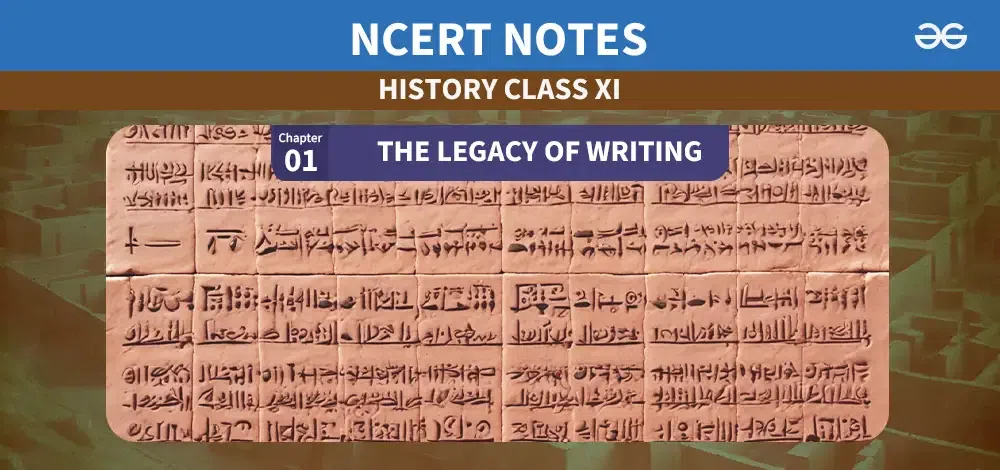Chapter 1: The Legacy of Writing| Class 11 History Notes
Last Updated :
03 May, 2024
In the annals of human history, few developments rival the transformative impact of writing. While oral traditions can preserve narratives, the advancement of science necessitates written texts to transmit knowledge across generations. Mesopotamia, often hailed as the cradle of civilization, bequeathed to the world a rich scholarly tradition that revolutionized fields such as mathematics and time reckoning.
Let us learn more about the legacy of writing!

Chapter 1: The Legacy of Writing| Class 11 History Notes
The Legacy of Writing
Mesopotamia’s greatest legacy to the world is its scholarly tradition of time reckoning and mathematics, dating back to around 1800 BCE. Tablets from this era contain multiplication and division tables, square and square-root tables, and even compound interest calculations. For example, the square root of 2 was calculated as 1 + 24/60 + 51/602 + 10/603, demonstrating their advanced mathematical knowledge.
Students were tasked with solving practical problems, such as determining the volume of water in a field covered to a certain depth. Additionally, Mesopotamians established the division of time into 12 months, 4 weeks per month, 24 hours per day, and 60 minutes per hour, which are standard today. These time divisions were adopted by subsequent civilizations and transmitted to medieval Europe.
Furthermore, Mesopotamians recorded significant celestial events like solar and lunar eclipses and observed the positions of stars and constellations. None of these achievements would have been possible without writing and the urban institution of schools, where students studied and copied written tablets. Some boys were trained not only as record keepers but as intellectuals capable of building upon their predecessors’ work.
The preoccupation with Mesopotamia’s urban world and preservation of texts and traditions is not a modern phenomenon. Early attempts were made to locate and preserve ancient texts and traditions, reflecting the importance placed on knowledge and intellectual heritage in Mesopotamian society.
Pioneering Mathematical Insights
Dating back to around 1800 BCE, Mesopotamian tablets reveal remarkable mathematical prowess. Multiplication and division tables, square- and square-root tables, and even compound interest calculations demonstrate the sophistication of ancient Mesopotamian mathematics.
For instance, the approximation of the square root of 2, though slightly imprecise by modern standards, showcases their adeptness at mathematical problem-solving.
The square root of 2 was given as:
1 + 24/60 + 51/602 + 10/603
Foundations of Time Reckoning
Mesopotamians laid the groundwork for modern time reckoning systems, shaping our daily lives in profound ways. Dividing the year into 12 months, the month into four weeks, and the day into 24 hours, with each hour further segmented into 60 minutes, originated from Mesopotamian civilization.
These time divisions, crucial for coordinating societal activities, were later adopted by successive civilizations and transmitted across cultures.
Observations of Celestial Phenomena
Ancient Mesopotamians meticulously recorded celestial events such as solar and lunar eclipses, noting their occurrence based on precise calendars.
Observations of stars and constellations in the night sky facilitated advancements in astronomy, laying the groundwork for future scientific inquiry into the cosmos.
The Role of Education and Scholarly Institutions
Central to Mesopotamia’s intellectual legacy were its urban institutions of learning and the practice of writing. Schools served as crucibles of knowledge, where students read and copied written tablets, perpetuating a cycle of learning and innovation.
Beyond mere record-keeping, select students were groomed as intellectuals capable of expanding upon the discoveries of their predecessors, ensuring the continuity of scholarly pursuits.
Conclusion
The enduring legacy of Mesopotamian writing underscores the indomitable spirit of human ingenuity. From mathematical innovations to the standardization of time reckoning, Mesopotamia’s contributions laid the groundwork for millennia of scientific progress.
The Legacy of Writing- FAQs
How did Mesopotamian mathematics influence subsequent mathematical developments?
Mesopotamian mathematical tablets, dating back to 1800 BCE, contain multiplication and division tables, square- and square-root tables, and even compound interest calculations. These foundational mathematical insights served as precursors to later mathematical advancements, influencing the trajectory of mathematical thought.
What were some practical applications of Mesopotamian mathematical knowledge?
Mesopotamian mathematical expertise extended beyond theoretical calculations to practical applications in daily life. For instance, they solved real-world problems such as determining the volume of water in a field covered to a certain depth, showcasing the utility of their mathematical prowess in various domains.
How did Mesopotamian time reckoning systems shape modern concepts of time?
Mesopotamians introduced fundamental time reckoning systems, including the division of the year into 12 months, the month into four weeks, and the day into 24 hours with each hour subdivided into 60 minutes. These time divisions, adopted by subsequent civilizations, form the basis of modern timekeeping practices.
What role did education and scholarly institutions play in Mesopotamia’s intellectual legacy?
Mesopotamia’s urban institutions of learning served as hubs of intellectual activity, where students read and copied written tablets, perpetuating a cycle of knowledge transmission. Beyond basic literacy, these institutions groomed select individuals to become intellectuals capable of building upon the discoveries of their predecessors.
How did Mesopotamian observations of celestial phenomena contribute to the development of astronomy?
Ancient Mesopotamians meticulously recorded celestial events such as solar and lunar eclipses, as well as the positions of stars and constellations in the night sky. These observations provided crucial data for early astronomical studies, laying the foundation for subsequent advancements in the field of astronomy.
Share your thoughts in the comments
Please Login to comment...